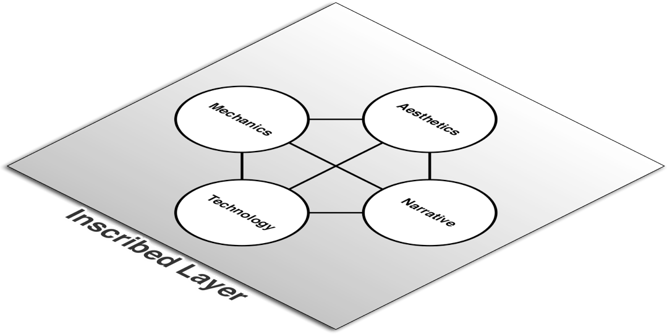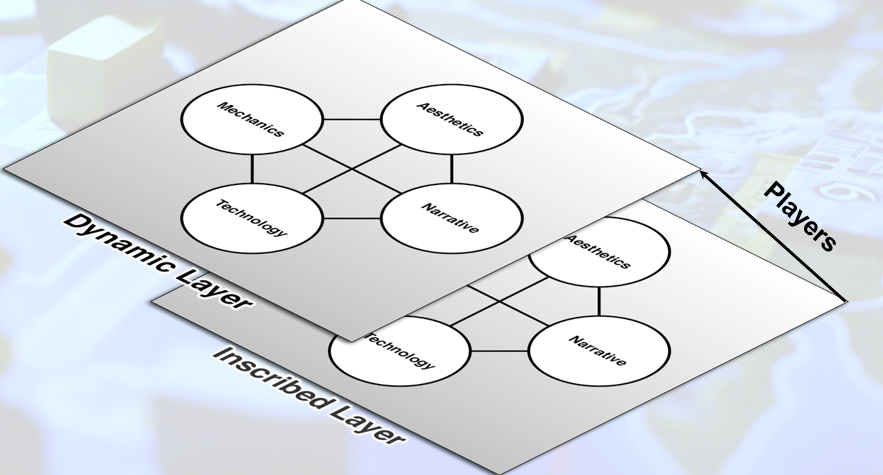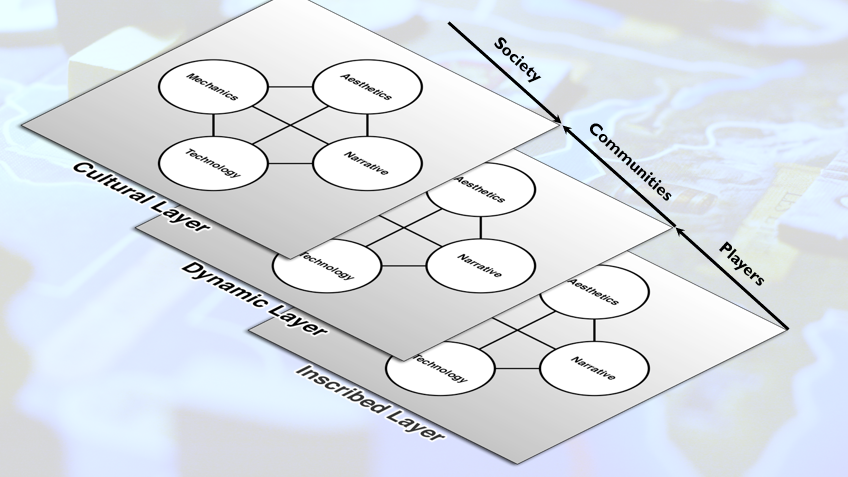The Layered Tetrad
The Layered Tetrad expands upon those that came before it. It considers the cultural significance and impact of games.
Once again it does not define what a game is, instead helps you understand and analyse
- The elements that are needed to make a game
- The dynamic behaviour of those elements during play
- Both the impact of the game on culture and the affect of culture on the game
The Layered Tetrad is presented in a tetrad that is based on Schell’s -
- Mechanics: The systems that define how the game will react to play. The elements that separate games from other media
- Aesthetics: The looks, sounds, smells, tastes, and tactile sensations of the game. Game art, sound, and more.
- Technology: The underlying tech that makes the game work.
- Narrative: The story, premise, characters, etc. of the game. Renamed from Schell’s to show its breadth.
This framework expanse on the tetrad by considering it in three layers
- Inscribed: The game as created and encoded by the developers
- Dynamic: The game’s behaviour during play
- Cultural: The game’s relationship to society
The Inscribed Layer
The Inscribed Layer focuses on the game as created and encoded by developers. It is similar to Schell’s Elemental Tetrad. It is limited to elements that exist when the game is not being played.

- Mechanics - Systems that define how the player and game will interact, Includes: Player interaction pattern, Objective, Rules, Resources, Boundaries
- Aesthetics - How the game looks, sounds, smells, tastes, and feels
- Technology - Paper and digital technology that enable gameplay
- Narrative - Authored premise, characters, and plot
The Dynamic Layer
The dynamic layer focuses on the game as it is being played. The involvement of players moves the game into the dynamic layer.

- Mechanics - Players’ interactions with inscribed mechanics, Includes: Procedures, Strategies, Emergent game behaviour, Outcome
- Aesthetics - Aesthetics that are generated during play, Play environment
- Technology - Execution of inscribed technology and code
- Narrative - Narrative created as a part or result of gameplay
The Cultural Layer
The Cultural Layer focuses on the game beyond play, on the intersection of game community and society.

- Mechanics - Game mods created by players that alter the Inscribed Layer, Impact of emergent play on society
- Aesthetics - Fan art, remixes, cosplay, Does not include authorized transmedia
- Technology - Game tech used for non-game purposes, Effect of external cheating technology on game
- Narrative - Fan-made narratives
The divisions between the four elements are less crisp in the Cultural Layer. The four elements intermingle in several of the examples above. The Cultural Layer is also the only layer of a game that non-players will ever see. People who don’t play a game experience it through the stories told by those who have. This is the collision of the community of players and larger society. What messages are our games sending into society?
The Responsibility of the Designer
All designers understand their responsibility for the Inscribed Layer. Most understand their responsibility for the Dynamic Layer (embracing or patching away unintended behaviours/abilities in game).
Increasingly designers and gamers are expressing concern about responsibility at the Cultural Layer.
The common perception of games is that they are Puerile, Vulgar, Violent, Misogynistic.
Does it have to be this way?
Games can be… Prosocial, Educational, Meaningful. What else?
There are also issues of representation and inclusion.
- What can interactive media become?
- How can you as designers push the term game beyond what it means now?
- How can you make your families and friends proud that you’re entering this industry?
- How can you respect your players and treat them well?
- It is our responsibility as designers to
- Promote pro-social, thoughtful behaviour through our games
- Respect our players and the time that they dedicate to experiencing what we create.
The layers are covered in more detail here